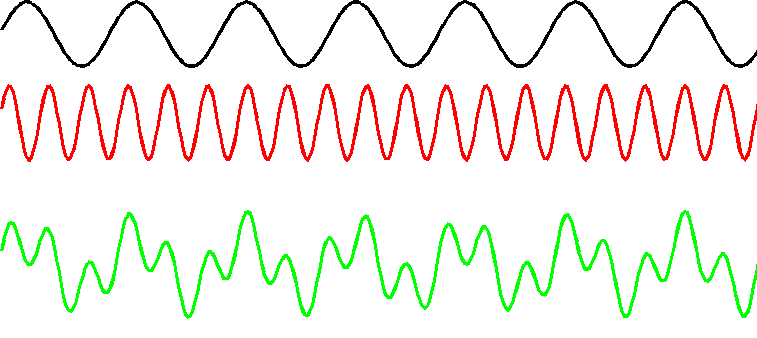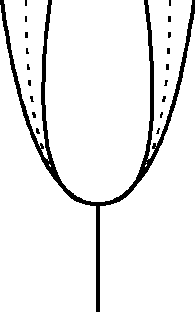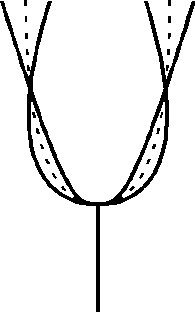
4.2 Overtone Series, Addition of Waves and Tone Quality
We have, so far, left out a very significant point. We have discussed the fundamental frequency of a vibrating system and its scaling with length. We also are aware of the fact that there are many possible modes of vibration each with its own vibrational frequency. This set of frequencies is called an overtone series and can be a non-harmonic, a harmonic, or a partial harmonic series. The key point, here, is when a note is sounded on an instrument, ALL of the different modes of the instrument can start vibrating, and each mode contributes its own frequency to the overall sound produced. This is what makes each instrument sound different, or what gives each instrument its own tone quality or timbre.
However, it gets even a bit more complicated, because each mode does not necessarily contribute the same amount of sound, even for the same note on the same instrument. If you pluck a guitar right in the middle of the string, it will sound quite different than if you pluck the string very close to one end of the string. Even though it is the same instrument playing the same note, the two ways of playing the note can sound different. A violin can be plucked or bowed. These two ways of playing the note, again, sound very different, even if the pitch is the same and the instrument is the same. What is changing is the amount of each overtone contributing to the tone quality.
We have looked at vibrating strings, but an assumption was that the string is perfectly flexible. In other words, it has no stiffness. A piece of thread or dental floss falls in this category. The strings on a guitar are also fairly flexible while the violin strings have a bit of stiffness. The most extreme case is a piano string. Piano strings are so stiff they are rather hard to work with. As we will see, this changes the overtone series and affects the tone quality of a piano in addition to how it is tuned.
Addition of Waves
Back in Section 2.1, we discussed the fact that the shape of a wave determines its tone quality, yet, now we are saying that it is the overtones that determine the tone quality. What is going on? Well, these are actually the same statement!
A pure note, one with no overtones, has a shape that is a sine wave:

A pure note with twice the frequency has a shape that looks like this:

Now, letís consider that we are playing a note that contains the second harmonic (which is twice the frequency of the fundamental). What does the shape look like? Actually, all that we have to do is add the two shapes together and we get:

There are several important aspects to this new shape. First, its shape is not a simple sine wave, so it will sound richer than just a pure tone. Second, even though the shape is different, the period and frequency are the same as the fundamental above. This is very important, because it means that the pitch stays the same. So, now we can see the connection between shape, harmonics and tone quality. If add harmonics to the fundamental, we change the shape of the wave, but not its pitch, so this gives us a way of independently controlling the tone quality without affecting the pitch. It does not matter if we add a wave at 3f, 7f, or 32f. The shape will change but the pitch will not.
Melodic vs. non-melodic instruments:
Up to now, we only considered the effect of adding a harmonic overtone to the fundamental, because there is a big difference if the overtone is harmonic or not. If the overtone is harmonic, the pitch does not change. Letís see what happens if we add an overtone which is not harmonic, for example, the first overtone of a vibrating bar at 2.76f:

Here, the fundamental is in black and the first overtone is in red. The sum of the two is in green. As we can see, the green wave is does not repeat with a well-defined period. If you listen to this sound, it will not have a clear pitch. You will hear both the fundamental and the overtone, but they do not support each other in establishing a pitch. A sound without a distinct pitch is usually regarded as unpleasant.
So, an instrument with harmonic overtones means that you can add the harmonics in various amounts to adjust the tone quality while preserving a sense of pitch and producing a pleasing sound. A skilled player can vary the mixture of harmonics to change the tone quality to suit the mood of the music, whether it is bright and clear, mellow, or dark and rich.
This is not possible with a non-harmonic instrument. For the most part, the overtones must be suppressed, or an unpleasant sound without a strong pitch will be produced. Of course, sometimes, this is what is called for. Cymbals, for example, fall into this category. They are used for sound effects, but not for pitch, melody or harmony.
An instrument like a xylophone can be used to play a melody, but this only works because the overtones are greatly suppressed Ė you only hear the fundamental. While this avoids the harshness of non-harmonic overtones, there is also no ability to change the tone quality. Thus, the range of expression is greatly restricted in this type of instrument. This is why they are still relegated to the percussion section.
Drums are like cymbals, in that they are used for effect, not melody or harmony. One exception is the timpani (or kettledrum). Here again, great effort has gone into designing timpani to bring their overtones close to harmonics. When this is achieved, the drum gains a sense of pitch. This is also why symphony tympani are so expensive.
One way the overtone mixture can be controlled in a vibrating bar is by how the bar is supported. To hear the fundamental, the ends must be free to vibrate. So the bar cannot be held at the ends. However, since the nodes are positions where the bar does not vibrate, it can be held at those points without damping the vibration. This point is about 22% of the length of the bar from each end and you can see this on any xylophone. But, these points are not nodes for the higher modes of vibration, so all of the higher modes will be damped out. Thus, just by how the bars are held allows the fundamental to vibrate and suppresses all of the other modes. What would happen if a bar was held just at one point exactly in the middle of the bar?
Overtones and Instruments
The overtones also affect the construction of instruments. An example of that was seen in the last section where it was mentioned that the shape of a vibrating bar could affect the overtone series. The first overtone of a bar is at 2.76f. This is not close to any harmonic or even any of the intervals that we know. However, if we go up an octave and a perfect fourth from the fundamental we get to 2(4/3)f = (8/3)f = 2.67f. So, if we could adjust the first overtone of the bar slightly and bring it down from 2.76 to 2.67, the bar would sound much better.
Along the same lines we will discuss two other examples: grand pianos and tuning forks.
Strings on a Grand Piano
As mentioned above, there is actually a continuum between steel strings and metal bar. A very thin metal wire is very flexible and behaves like an idea string. For example, the first overtone is at the harmonic frequency 2f. Now, as the wire gets thicker, it takes on some stiffness. This has the effect of making the overtones higher than they should be. The musical term for this is that the overtones become sharper. The stiffer the string or wire, the sharper the overtones. In the limit that the wire becomes so thick that you would consider it a bar instead of a string or wire, the first overtone is at 2.76f not 2f.
So, on a piano, because of the thick wire strings, the overtones are all slightly sharp. It is noticeable and a good piano tuner will correct for this. Say you first tune middle C to its standard pitch, which we will call f. The C three octaves higher should be at (2)3 = 8f. The 2nd overtone of middle C should also be 8f. However, because of the stiffness, it is more like 8.1f. Because many of the overtones sound when you strike a note on a piano, it turns out to be more important to tune the third octave above middle C to the 2nd overtone of middle C, rather than making it exactly 3 octaves higher. This way of tuning is called "stretching the octaves" because each octave becomes slightly larger than it would normally be. This happens naturally if a piano is tuned by ear, because the octaves sound better if the overtones are in tune.
Of course, there is a limit to this. If the overtones are too sharp, the octaves will deviate too much from their ideal value. So, this, in turn, limits the size of a piano. Full concert grand pianos are the biggest instrument there is. The goal is to use as long a string as possible, because this will make the piano louder and the tone richer. However, if you keep making the strings are longer, either the tension must be increased, or the strings made thinner to keep the pitch of the string the same, according to the relationship:

The problem is that thinner strings will break. So the tension must be increased, which will also break the strings. So, in the end the strings must be made thicker. Although the thicker string will now decrease the frequency, this is more than compensated by the increase tension made possible by the thicker string. Ultimately, the strings become so stiff that the overtones will be too far out of tune to sound good. In fact, modern grand pianos have reached their limit in size, unless, of course, new material, which is stronger, but not stiffer, can be found. Finally, if the string or bar is thick enough, you don't need any tension to make it vibrate and you end up with the limit of the vibrating bar
Tuning forks
A string has many harmonic overtones giving a warm and rich tone quality. However, having all of the harmonics present does make the pitch a little bit less distinct. So, it is harder to tune an instrument precisely to a violin, or any other instrument. A metal bar in the shape of a "U" actually offers a useful alternative:

Fundamental, 1f

Next lowest mode, 5.3f - a very high frequency
This clever arrangement makes each "tine" of the fork act like a metal bar clamped at one end. We examined the possible modes in this case, in the previous section. In the figure above, we see that the next higher mode is at 5.3f. This is so high that the ear can easily ignore it. Because of this, the brain can focus in on just the fundamental. This provides a pure and precise pitch to tune an instrument to. Moreover, all tuning forks will sound the same, as there is no difference in overtone pattern from one tuning fork to another as there are no significant overtones present, at all.